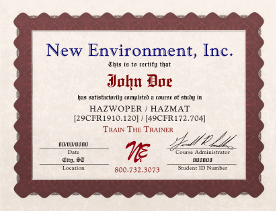HAZWOPER/HAZMAT Train The Trainer

Trusted HAZWOPER/HAZMAT Instructor Certification
Our HAZWOPER/HAZMAT Train The Trainer (HH-TTT) certification is a respected credential recognized by both public and private organizations nationwide, it sets the standard for excellence in safety training.
Comprehensive Training Curriculum
You’ll receive a complete curriculum that will empower you with the knowledge and confidence to deliver effective in-house HAZWOPER and HAZMAT training.
Expert Support
We are the HAZWOPER Experts! Call us today to discuss your training needs: 800.732.3073
Unlike many competitor programs, our HH-TTT program goes far beyond a class and a certificate. Each participant receives a full training package—including detailed lesson plans, immersive PowerPoints, and dozens of videos—covering key safety topics in 1910.120, 1910.146, 1910.1200, and 172.704.
Participants also gain access to our MyTTT portal for downloading updated materials, discounted online courses, training record submissions, and more.
Add third-party student certification and expert regulatory support, and it’s easy to see why we've led the HAZWOPER training industry for over 30 years.
Explore the full program and benefits below.
49CFR 172.704 (a)-(c)
Jump To Section
Program Includes |
Other Course Options |
Regulation |
Individual Products
Live Open Enrollment Seminars
Our week long open enrollment HAZWOPER/HAZMAT Train The Trainer seminars equip you to train your students at a professional level. Our senior instructors have decades of real world experience and relay the instructional content in a relatable and engaging manner. Please do not hesitate to contact us with any questions.
HAZWOPER/HAZMAT Train The Trainer Seminar - Denver, CO on Jul 14 - 18, 2025
Class Location: Fairfield Inn & Suites - Brighton Colorado (View Location Details)
Denver, Colorado Location & Directions

Fairfield Inn & Suites Denver Northeast/Brighton
948 Platte River BoulevardBrighton , Colorado 80601
Phone: 303.637.0910
Fax: 303.637.0902
Use Group Code: NETNETA for a discounted rate
View More Detailed Hotel Information
This will take you to the Hotels website. Get Driving Directions

HAZWOPER/HAZMAT Train The Trainer Seminar - Richmond, VA on Aug 11 - 15, 2025
Class Location: Hampton Inn & Suites - Richmond, Virginia (View Location Details)
Richmond, Virginia Location & Directions

Hampton Inn & Suites Richmond/Glenside
5406 Glenside Dr.Richmond, VA 23228
Phone: 1-804-756-1777
To make arrangements for a hotel stay please call the Hotel directly, or book online.
Click Here For More Detailed Hotel Information Get Driving Directions

HAZWOPER/HAZMAT Train The Trainer Seminar - Houston, TX on Sept 15 - 19, 2025
Class Location: La Quinta - Channelview, Texas (View Location Details)
Houston, Texas Location & Directions

La Quinta Houston East
16211 East FreewayChannelview, Texas 77530
Phone: 281.864.5293
If you need to make arrangements for a hotel stay please call the Hotel directly and Mention New Environment, Inc. to receive a discounted room rate of $69.00 plus tax.
View More Detailed Hotel Information
This will take you to the Hotels website Get Driving Directions

HAZWOPER/HAZMAT Train The Trainer Seminar - Baltimore, MD on Oct 6 - 10, 2025
Class Location: Best Western Plus BWI Airport - Elkridge, Maryland (View Location Details)
Baltimore, Maryland Location & Directions

Best Western Plus BWI Airport/Arundel Mills
6755 Dorsey RoadElkridge, Maryland, 21075
Phone: 410.796.3300
Fax: 410.379.0471
Mention New Environment for a special nightly rate of $99, Or book online via the link below.
Book Online or View More Detailed Hotel Information.
This will take you to the Hotels website Get Driving Directions

HAZWOPER/HAZMAT Train The Trainer Seminar - Reno, NV on Nov 17 - 21, 2025
Class Location: Fairfield Inn & Suites Reno/Sparks - Sparks, Nevada (View Location Details)
Reno, Nevada Location & Directions

Sparks, Nevada 89434
Phone: 775.355.7700
Mention New Environment for a special room rate or book online.
View More Detailed Hotel Information
This will take you to the Hotels website. Get Driving Directions

HAZWOPER/HAZMAT Train The Trainer Seminar - Houston, TX on Dec 8 - 12, 2025
Class Location: La Quinta - Channelview, Texas (View Location Details)
Houston, Texas Location & Directions

La Quinta Houston East
16211 East FreewayChannelview, Texas 77530
Phone: 281.864.5293
If you need to make arrangements for a hotel stay please call the Hotel directly and Mention New Environment, Inc. to receive a discounted room rate of $69.00 plus tax.
View More Detailed Hotel Information
This will take you to the Hotels website Get Driving Directions

Web-Based Course Option - NO TRAVEL REQUIRED!
New Environment, Inc. is a pioneer in web-based HAZWOPER training. Our HAZWOPER/HAZMAT Train The Trainer Self-Study (HH-TTTSS) package provides you all the same rights, materials, certifications and resources as one of our live open enrollment seminars, with the added convenience of working from your own home or office. Plus, we have tenured instructors standing by to assist you with any questions you may have while completing the course (during our normal business hours). You can start work on your course almost immediately after purchase and the physical materials and resources will be shipped to you quickly.
Train The Trainer Self-Study Package

This self-study program is a fantastic alternative to attending a live seminar. To qualify for this online self study course you must be able to show by documentation or certification that your work experience and/or training has resulted in "at least 24 hours" of prior training equivalent to training required in paragraphs (e)(1) through (e)(4) of 29 CFR 1910.120.
Examples of "Qualified" individuals include: Prior experience in Occupational Safety and Health or hazardous waste operations or emergency response, or an Associate's or Bachelor's Degree in a physical or natural science or engineering, with course work in chemistry.
Individuals wishing to utilize this self study option should also be able to demonstrate (by means of professional resume or letter from employer) experience as an instructor/trainer in a professional capacity.
Program Includes
-
Web access to The HAZWOPER / HAZMAT Self-Study Program:
- Includes thorough coverage of the HAZWOPER/HAZMAT subject matter and Instructional Skills Training as required by OSHA.
-
Detailed Lesson Plans:
- A complete set of easy to use Lesson Plans covering each of our HAZWOPER/HAZMAT programs.
- You will also receive a complimentary copy of our Permit-Required Confined Space, DOT HAZMAT HM-126F and Hazard Communication course Lesson Plans. (View a Sample)
-
One Year Subscription to our MyTrainTheTrainer (MyTTT) Portal:
- The Subscription includes downloadable instructor resources like Lesson Plans, PowerPoints and Videos. As well as digital submission of training records for third party certification. It also includes access to our CERTs Online Training Program.
-
A HAZWOPER/HAZMAT PowerPoint Package:
- All of our HAZWOPER/HAZMAT PowerPoint® programs on one drive. ($650.00 Value)
-
A Complimentary Basic Video Package:
- This Package contains 100+ (8.75 GiB's) safety training videos. The Classroom Videos folder located on the flash drive includes Basic videos from the Occupational Safety and Health Administration (OSHA) and the U.S. Department of Labor (DOL). There is also a folder with accident investigation/recreation videos from the Chemical Safety Board (CSB). Every video used to teach any of our training courses is included on the flash drive.
Our HAZWOPER Curriculum has been endorsed and approved by thousands of companies, universities, and government agencies including: The US Army EOD command, Houston Area Safety Council, IL Department of Natural Resources, The Department of Transportation, Boise State University, and more. (View our References)
It was probably the best training course I took in 20+ years just based on how well it was organized and how well the whole week was planned. The materials were absolutely incredible to be able to take back with us and I’ve already got some great ideas for planning and preparing my own training."
Andrew D.
"The New Environment program makes HAZWOPER training easy. As an instructor, their materials are easy to use and packed with bonus curriculum and extra training aids... The New Environment Train-The-Trainer program are the best in the industry."
Phil B.
NEI's trainer did an awesome job, one of the best instructors I have had in my career. NEI's lesson plans and products were well thought out and we are looking forward to using them.
Stephen S.


Upon successful completion of the course each trainer receives the following New Environment, Inc. certifications:
- "HAZWOPER/HAZMAT Train The Trainer"
- "24-Hour Hazardous Materials Technician"
- "40-Hour Hazardous Waste Worker"
- "On-Scene Incident Commander"
- "8-Hour Hazardous Waste Supervisor"
Program Includes
-
Five Days of Class Room Instruction:
- Includes thorough coverage of the HAZWOPER/HAZMAT subject matter and Instructional Skills Training as required by OSHA. Our tenured instructors will bring you to a solid understanding of OSHA regulations and how they apply to various industries. You will explore the content of our course lesson plans and receive instruction on how to utilize them effectively in your own training environment. View Course Agenda
A Complimentary Video Package:
- This video package contains over 100 safety training videos including titles from the Occupational Safety and Health Administration (OSHA), the U.S. Department of Labor (DOL), and the Chemical Safety Board (CSB). Every video needed to teach any of our training courses is included in your trainer package and more titles are added regularly.
-
Full HAZWOPER/HAZMAT PowerPoint:
- All of our HAZWOPER/HAZMAT PowerPoint programs at your fingertips. Our PowerPoint programs are professionally designed to keep your students on track and engaged with your presentation. In addition to the primary training courses there are also dozens of topical presentations on the drive including heat stress, cold exposure, lockout-tagout, and CPC. You will also find sample site safety plans, hands on training outlines and much more. All of our PowerPoints are customizable allowing you to make the presentation your own. (View a Sample)
-
Detailed Lesson Plans:
- A complete set of easy to use Lesson Plans covering each of our HAZWOPER/HAZMAT programs. These lesson plans are designed by our professional trainers and are the same plans New Environment instructors use everyday. (View a Sample)
-
- You will also receive a complimentary copy of our additional course lesson plans including:
-
Free Access To Our My Train The Trainer (MyTTT) Portal:
- One year access to our "My Train The Trainer" Portal will allow online access to supplementary and updated lesson plans, PowerPoints, and videos enabling you to keep your training materials up-to-date wherever you are!
- You will also have access to heavily discounted online self-study programs. Now you can provide training solutions for employees across town or around the world.
- Streamline the certification process with the new online training record submission.
Program Benefits
-
Flexibility:
- New Environment, Inc.'s HAZWOPER/HAZMAT Train The Trainer Program gives you complete control over your training schedule allowing you to conduct classes when and where you need them. You also have freedom to customize courses to better meet your facility's unique needs.
-
High Quality Student Materials Are Available:
- We offer a complete line of professionally designed student materials and visual aids. Available for separate purchase, our Student Materials are designed to promote learning retention and student attentiveness.
-
Third Party Certification:
- When you use NEI's Lesson Plans and Student Material for your training we will provide you with certificates for each individual you instruct. In addition to a hard copy certificate, we will also maintain digital records of your training, ensuring you will have a backup copy of your training when you need it most.
-
Expert Support:
- New Environment, Inc. has been considered a HAZWOPER/HAZMAT authority for over 30 years. As a NEI Certified trainer you will be able to contact us with your health and safety training questions; we can help you find the answers you are looking for.
-
Peace of Mind:
- Because you will be conducting your own training courses you can have confidence your students have been trained in the areas vital to their specific job function. Our courses are designed to give you the support you need to achieve and maintain regulatory compliance.
Course Regulation
This course is intended to improve the instructional skills, abilities, and knowledge of HAZWOPER/HAZMAT trainers. Participants will be required to present at least one 30-minute training segment on a health or safety topic chosen during the course. Approval as a Trainer is required through 29 CFR 1910.120 (e)(5) & (q)(7).
29 CFR 1910.120: Qualifications for Trainers:-
(e)(5):
Qualifications for trainers.
- Trainers shall be qualified to instruct employees about the subject matter that is being presented in training. Such trainers shall have satisfactorily completed a training program for teaching the subjects they are expected to teach or they shall have the academic credentials and instructional experience necessary for teaching the subjects. Instructors shall demonstrate competent instructional skills and knowledge of the applicable subject matter.
-
(q)(7):
Trainers.
- Trainers who teach any of the above training subjects shall have satisfactorily completed a training course for teaching the subjects they are expected to teach, such as the courses offered by the U.S. National Fire Academy, or they shall have the training and/or academic credentials and instructional experience necessary to demonstrate competent instructional skills and a good command of the subject matter of the courses they are to teach.
-
Appendix E - (3):
Instructors.
- Instructors should be deemed competent on the basis of previous documented experience in their area of instruction, successful completion of a "train-the-trainer" program specific to the topics they will teach, and an evaluation of instructional competence by the Training Director.
The Following Topics are Covered in this Course
-
29 CFR 1910.120 Regulatory Overview:
- (e)(3) through (e)(9)
- (q)(6) through (q)(8)
- Appendix E (3)
- General Hazard Awareness / First Responder Awareness Course Presentation
- Hazardous Waste Worker / Hazardous Materials Technician Course Presentation
-
Procedures For Train The Trainer:
- Student Classroom Materials
- Ordering Classroom Material Procedures
- NEI Online Portal Paperwork Submission
- 3rd Party Certification Procedures
-
Explanation Of The Train The Trainer Classroom Material:
- Binder Layout & Use
- Reference Materials
- NEI Instructor Toolkit
- Basic Safety Training / First Responder Operations Course Presentation
- Hazardous Waste Supervisor / On Scene Incident Commander Course Presentation
- Instructor Presentation Skills training is conducted throughout the course. Each trainee will be given the opportunity to personalize their copy of the instructor lesson plan(s) and conduct at least one 30-minute presentations on a course topic.
- Timelines for the course presentation may vary according to student questions and site-specific priorities.
Other Course Options (click a title for product information)
On-Site Training
New Environment, Inc. offers On-Site Training for this course, call or E-mail us to schedule this course.
Individual Products (click a title for product information)
Instructor Materials
HAZWOPER/HAZMAT Lesson Plan Package (Included in Tuition)

Get all of our HAZWOPER/HAZMAT lesson plans in two binders that include the following:
- Hazardous Waste Operations and Emergency Response Regulations
- Instructor Presentation Skills and Evaluating Instruction
- 4-Hour Emergency Response Awareness / 4-Hour General Hazard Awareness
- 8-Hour Emergency Response Operations / 4-Hour Basic Safety Training
- 24-Hour Hazardous Materials Technician / 40-Hour Hazardous Waste Worker
- 8-Hour On-Scene Incident Commander / 8-Hour Hazardous Waste Supervisor
- 8-Hour Emergency Response Refresher / 8-Hour Hazardous Waste Refresher Version-A
- 8-Hour Emergency Response Refresher / 8-Hour Hazardous Waste Refresher Version-B
- 8-Hour Emergency Response Refresher / 8-Hour Hazardous Waste Refresher Version-C
- 8-Hour Permit-Required Confined Space
- 8-Hour Department Of Transportation HM-126F Program
- 2-Hour Hazard Communication Program
HAZWOPER/HAZMAT PowerPoint Package (Included in Tuition)

Get all of our HAZWOPER/HAZMAT PowerPoint® programs on a portable flash drive that includes the following:
- 4-Hour Emergency Response Awareness / 4-Hour General Hazard Awareness
- 8-Hour Emergency Response Operations / 4-Hour Basic Safety Training
- 24-Hour Hazardous Materials Technician / 40-Hour HAZWOPER Worker
- 8-Hour On Scene Incident Commander / 8-Hour HAZWOPER Supervisor
- 8-Hour Emergency Response Refresher / 8-Hour Hazardous Waste Refresher Version-A
- 8-Hour Emergency Response Refresher / 8-Hour Hazardous Waste Refresher Version-B
- 8-Hour Emergency Response Refresher / 8-Hour Hazardous Waste Refresher Version-C
- 8-Hour Permit-Required Confined Space Safety (BONUS)
- 2-Hour Hazard Communication Program (BONUS)
- 8-Hour HM-126F Department Of Transportation (BONUS)
- 29 CFR 1910.120 Regulation In PowerPoint Format
- 29 CFR 1910.146 Regulation In PowerPoint Format (BONUS)
- 29 CFR 1910.1200 Regulation In PowerPoint Format (BONUS)
Student Materials
View Student Training MaterialsView Supplemental Student Materials

